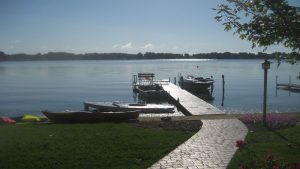On August 15, the U.S. Court of Appeals for the Tenth Circuit decided the case of Sinclair Wyoming Refining Company, et al., v. U.S. EPA. In a split decision, the Tenth Circuit vacated a final order of the Environmental Protection Agency (EPA) which denied the plaintiff small refiners’ request for an exemption from the strictures of EPA’s Renewable Fuels Standards (RFS) Program.
Articles Posted in Environmental
Fifth Circuit Vacates Denial of Charitable Tax Deduction For Conservation Easements
On August 11, the U.S. Court of Appeals for the Fifth Circuit decided the case of BC Ranch II, LP, et al., v. Commissioner of Internal Revenue, which involved charitable tax deductions based on the creation of conservation easements. After reviewing the record, the Fifth Circuit, in a split decision, disagreed with both the Commissioner and the Tax Court, placing heavy stress on the Internal Revenue Code’s public policy goals:
[T]he hope of adding untold thousands of acres of primarily rural property for various conservation purposes – acreage that would never become available for conservation if land-owning potential donors were limited to the traditional method of conveyance.
Office of Planning and Research Releases Updated General Plan Guidelines
On August 2, 2017, the California Governor’s Office of Planning and Research (“OPR”) released its first update to the General Plan Guidelines (the “Guidelines”) since 2003. The Guidelines provide guidance to cities and counties throughout California on the preparation and content of their General Plans, which govern land uses and zoning within their jurisdictions. The updated Guidelines contain new recommended policies, information resources, and reflect recent legislation regarding General Plans.
Texas’ 2017 Environmental Legislation Summary
The Texas Legislature meets every two years, and, as befits a large state with varied interest and concerns, typically enacts  hundreds of new laws during these sessions. The 85th Regular Session of the Legislature has concluded, and over 1000 laws, dealing with matters large and small were passed and signed by the Governor. Most of these new laws will take effect on September 1, 2017.
hundreds of new laws during these sessions. The 85th Regular Session of the Legislature has concluded, and over 1000 laws, dealing with matters large and small were passed and signed by the Governor. Most of these new laws will take effect on September 1, 2017.
Can a RCRA Settlement Also Be Used as a Basis for a CERCLA Contribution Action?
On August 10, the U.S. Court of Appeals for the Ninth Circuit decided the case of ASARCO LLC v. Atlantic Richfield Company, which involves the ongoing liability to clean up the East Helena Superfund Site, located “in and around an industrial area in Lewis and Clark County, Montana.” The Ninth Circuit, vacating the U.S. District Court in Montana’s grant of summary judgment, held that
[Ansarco’s] 1998 RCRA Decree did not resolve Asarco’s liability for at least some of its response obligations under that agreement. It therefore did not give rise to a right to contribution under CERCLA § 113(f)(3)(B). By contrast, the 2009 CERCLA Decree did resolve Asarco’s liability, and Asarco has brought a timely action for contribution under that agreement.
New Groundwater Contamination Case: TVA Ordered To Excavate Large Quantities of Coal Ash Waste
On August 4, the U.S. District Court for the Middle District of Tennessee issued a very significant ruling in the case of Tennessee Clean Water Network, et al., v. Tennessee Valley Authority. The District Court has ordered the Tennessee Valley Authority (TVA) to excavate huge quantities of coal ash waste generated over many years by the TVA’s coal-fired power plant located in Gallatin, Tennessee, and adjacent to the Cumberland River.
Two large unlined surface impoundments have been used to store this waste: the Non-Registered Site and the Ash Pond Complex. According to the District Court, these waste pits are located in an area with “karst geological features, with sinking streams, shallow bedrock, and sinkholes.” These site characteristics caused the District Court to note that “it is difficult to imagine why anyone would choose to build an unlined ash pond in karst terrain immediately adjacent to a river.”
DC Circuit Weighs In on EPA’s Rule Establishing Renewable Fuel Requirements
In Americans for Clean Energy, et al v. EPA, decided July 28, 2017, the U.S. Court of Appeals for the District of Columbia  Circuit upheld the Environmental Protection Agency’s (EPA) 2015 rule establishing renewable fuel volume obligations for the years 2014 through 2017, with one exception: the court held that EPA cannot consider demand-side constraints in setting annual renewable fuel volumes.
Circuit upheld the Environmental Protection Agency’s (EPA) 2015 rule establishing renewable fuel volume obligations for the years 2014 through 2017, with one exception: the court held that EPA cannot consider demand-side constraints in setting annual renewable fuel volumes.
Sixth Circuit Balances Rights of Forest Service and Rights of Private Property Owners Provided by Michigan Law
Balancing the interests of the Federal Government as owner of thousands of acres surrounding Crooked Lake and private owners’ rights, on July 26,  in a 2 to 1 ruling, the U.S. Court of Appeals for the Sixth Circuit ruled that the U.S. Forest Service exceeded its authority when issuing rules restricting recreational use of Crooked Lake. The federal legislation acquiring the property for the Federal Government contained a provision protecting “valid existing rights.” According to the Court of Appeals, relevant Michigan law established such an existing right, granting owners of property surrounding the lake the right to reasonable use of the lake, and this law must be respected. The case is Herr v. U.S. Forest Service, et al.
in a 2 to 1 ruling, the U.S. Court of Appeals for the Sixth Circuit ruled that the U.S. Forest Service exceeded its authority when issuing rules restricting recreational use of Crooked Lake. The federal legislation acquiring the property for the Federal Government contained a provision protecting “valid existing rights.” According to the Court of Appeals, relevant Michigan law established such an existing right, granting owners of property surrounding the lake the right to reasonable use of the lake, and this law must be respected. The case is Herr v. U.S. Forest Service, et al.
Second Circuit Follows Viking Pump Methodology to Calculate Total Insurance Liability for Environmental Cleanup Efforts Spanning Years and Policies
On July 17, the U.S. Court of Appeals for the Second Circuit decided the case of Olin Corporation v. OneBeacon America Insurance Company, an environmental insurance recovery lawsuit. Olin Corporation has filed such lawsuits against several of its insurance carriers with respect to the contamination indemnification claims generated by Olin Corporation’s ongoing cleanups at its manufacturing facilities around the country. The Court of Appeals affirmed Olin Corporation’s right to recover and also agreed with OneBeacon America Insurance Company (OneBeacon) that the U.S. District Court for the Southern District of New York should have factored in the “prior insurance provision” of OneBeacon’s policies “thereby reducing the limits of its policies by those of any prior policies covering the same loss.”
SCOTUS Update: Environmental and Administrative Law Cases Decided in 2017
The 2016 Term of the U.S. Supreme Court was fairly quiet, perhaps reflecting the fact that with only eight members, the  Court needed a working consensus to handle its docket. The Court handed down seventy rulings, but only a few can be described as bearing on environmental or administrative law. A few rulings importantly concerned the operation of federal agencies and their enforcement authorities.
Court needed a working consensus to handle its docket. The Court handed down seventy rulings, but only a few can be described as bearing on environmental or administrative law. A few rulings importantly concerned the operation of federal agencies and their enforcement authorities.
 Gravel2Gavel Construction & Real Estate Law Blog
Gravel2Gavel Construction & Real Estate Law Blog


